Samsung QN95B Reviewed at $2,999.00 (55")
-
Design - 9.3/10
9.3/10
-
Video Quality - 9.3/10
9.3/10
-
Ports & Connectivity - 9.5/10
9.5/10
-
OS, Apps and Features - 9.5/10
9.5/10
-
Price / Quality - 8.8/10
8.8/10
Summary
Reviewed at $2,999.00 (55″)
Pros
- Great image quality
- Four HDMI 2.1 ports
- Slim One Connect Box
- Huge list of extras and online features
Cons
- No Dolby Vision or DTS
- Blooming still visible
- Mediocre sound
- You pay a premium price for just the One Connect Box
Cheapest Places to Buy :
*We are a reader-supported website. When you buy through links on our site, we may earn a small affiliate commission at no extra cost to you. Home Media Entertainment does not accept money for reviews.*
The inception of the One Connect Box from Samsung was an ingenious idea but unfortunately instead of Samsung using it across their entire lineup it has ended up being more of a niche feature than a trademark of their engineering. But until last year this magic box was missing from the US market as the QN95A was exclusive to certain European countries among others. But this finally seems to change and in our Samsung QN95B review we are going to test their best 4K LED TV on offer for 2022.
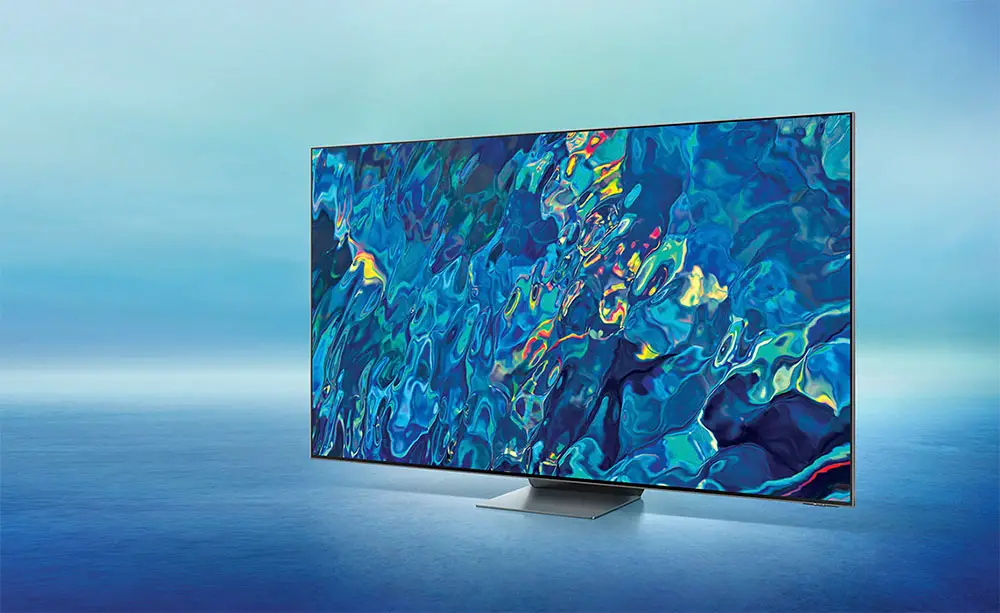
Now, the QN95B is a bit of a strange release to be honest. Looking at the specs you are not going to find major differences, if any at all, compared to the QN90B. But with a price difference of around $900 there must be something different to justify the cost. Basically their differences are centered around a slightly better processor, a slightly improved audio system, support for 144Hz across all sizes and the inclusion of the One Connect Box.
Going really fast over the specs we see that the QN95B will be offered in four sizes from 55″ up to 85″. It comes with a VA panel that can do both 120Hz and 144Hz, it uses Samsung’s top Neural Quantum Processor 4K, supports HDR10+ and for sound uses the Object Tracking Sound+ (OTS+) audio system with Dolby Atmos. This year, as with many Samsung models, we get four HDMI 2.1 ports and comes with the latest Tizen 2022 platform.
The differences between the QN95B and the QN90B are really small and if it was not for the One Connect Box there would be really no point of existence for this model. Is the price difference of about $900 justify the inclusion of the One Connect Box and is these really the only differences you are going to get? Keep reading to find out.
Design
The inclusion of the One Connect Box means that in terms of design the QN95B is more similar to other Samsung TVs that come with this box rather than all other top tier TVs that have their ports on the main body itself. In fact from what we saw the QN95B looks extremely similar to last year’s QN900A although we did spot some minor changes here and there.
The unit uses what Samsung calls their Infinity One design which basically is a slim form factor that is used in many of their flagship models. Along with it we get the Slim One Connect which is a new generation of the One Connect Box. The difference of this box compared to previous versions is that now this can be either attached to the back of the stand instead of being placed along side the TV itself. Also its size has increased considerably in comparison to older versions.
The thin profile is also due to the use of the new mini LED backlight which helps to minimize its overall thickness greatly, something that we measured at just 0.7″ (1.8 cm), making it look amazing if you plan on hanging it on a wall.
The back side of the TV is covered by a plastic panel that in true Samsung fashion has a brushed texture look on it. Just like the QN900A there are four woofers on each side exposed along with vertical perforated grilles that occupy each side that are part of the OTS+ audio system.
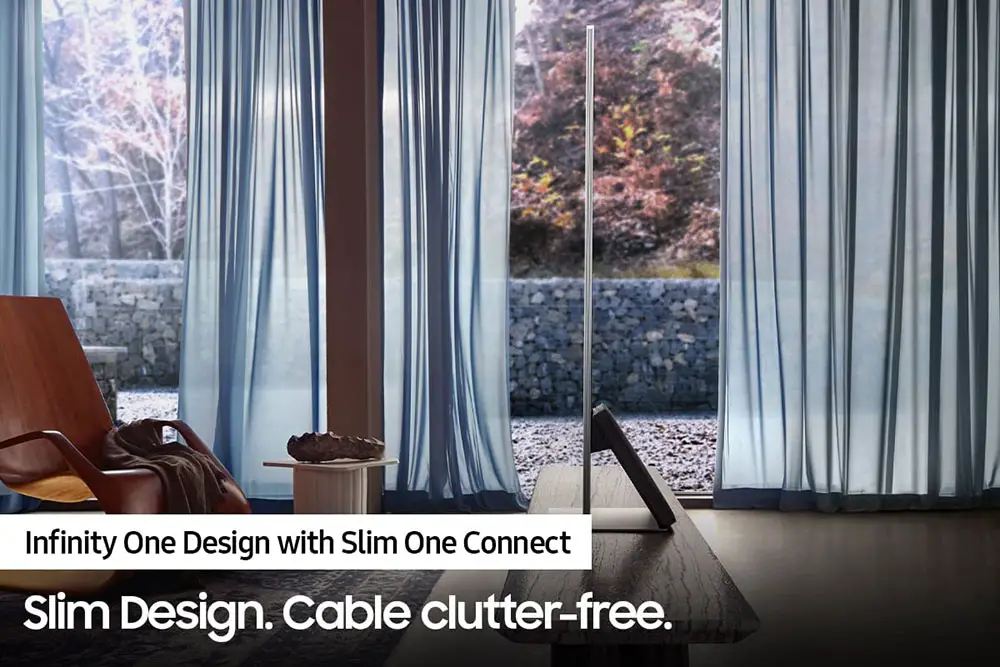
There is a single port in the center of the back panel along with a USB port and this is the main connection to the One Connect Box which houses everything else. Lastly there are holes for the VESA mount along with extra holes in order to attach the One Connect Box on the back panel in case you want to wall mount the TV and don’t want to have any cables exposed.
As for the stand, this is also the same as the one in the QN900A and is a center-mounted design which is good for small furniture but make sure that the TV is in a safe position as bigger sizes will surely wobble a bit more that what we would like. The back of the stand is designed in such a way in order to attach the One Connect Box on it if desired so you have plenty of options when it comes to where you want to position it.
We measured the space between the screen and our furniture and it was just a bit more that 3″ which should be plenty for almost all available soundbars out there. So you shouldn’t worry if one fits there in case you are considering it.
As for the remote that comes with the QN95B, this is the same across the entire 2022 lineup like the S95B, the QN90B or the Q80B we tested before. It looks similar to the year before but with some minor design changes that do not affect its practicality or everyday use. It is still small and uses very few buttons as it relies on the TV’s UI for most of its functions. It comes with a rechargeable battery that can be charged either through a USB-C cable or from its solar equipped back side. The only difference we find this year is that the top side is now seamless while a fourth dedicated button for Disney+ has been added.

All other features and characteristics of the remote return from previous years like its built-in microphone for voice commands and CEC commands control.
Overall the QN95B looks very nice. Build quality could be a bit better for such a premium release but at least our unit didn’t have any defects or manufacturing problems. We do like the One Connect Box and surely the latest generation of it, is the best of them all.
Video Quality
Processor technology used
In a rather puzzling move the QN95B is the only 4K mini LED from Samsung that uses the latest Neural Quantum Processor 4K. We had some previous experience with this new chip from our S95B review but in general we can say that we didn’t notice any specific differences compared to the next in line Neo Quantum Processor 4K and if there are any these are not visible at first glance.
As we said in our other reviews we don’t have detailed specs on this chip and if it is just an update of 2021’s Neo Quantum Processor 4K or something entirely new. But by judging from the marketing material it seems that this new processor is more of a small update as we tend to find in these yearly releases.

What Samsung has mentioned about this new processor is that it uses up to 20 different neural network models, an update over last year’s 16, with each trained in AI upscaling and deep learning technology, in order for the processor to optimize picture quality to 4K picture output regardless of the input quality.
Also its Real Depth Enhancer feature automatically separates objects in the content from the background and creates 3D like depth in order to make the image even more immersive.
We put the QN95B through our usual tests by trying several content in different resolutions from low quality 480p, 720p and even some in 1080p. We also used some broadcasting material and our general sense was that the TV upscaled everything in 4K nicely without any visible artifacts. To be honest we didn’t see the extra power of the Neural processor anywhere and its performance, at least from what we observed, was similar to the QN90B.
A few features we got the previous years also find their way here and one of them is Adaptive Picture which is a feature that analyzes the light conditions in your room and can calibrate the picture accordingly in order to provide you the best image quality for your specific situation. There is also an EyeComfort mode which intelligently adapts your display and reduces blue light to help keep your eyes more comfortable.

As for the sound the Neural Quantum Processor 4K works with the TV’s Object Tracking Sound+(OTS+), Adaptive Sound and Active Voice Amplifier (AVA) which is the same again as in the QN90B in terms of pure features availability.
Lighting technology used
The arrival of mini LED brought several improvements over what was previously possible with the older FALD backlights although this still has its fare share of problems.
The QN95B is using a Quantum Mini LED backlight as all Neo QLEDs have and it seems to be exactly the same as the one used last year which is precisely controlled by Quantum Matrix Technology. The major advantage of Quantum Mini LED is that it has 1/40 the height of a conventional LED.
Instead of using a lens to disperse light, and a package to fix the LED in place, the Quantum Mini LED has incredibly thin micro layers filled with many more LEDs. This way Quantum Matrix Technology has much better and more precise control of the densely packed LEDs, preventing what was the most obvious disadvantage of previous LCD backlight systems, blooming.
Keep in mind that while mini LED technology is vastly superior to any other LCD backlight system so far it is not alleviating the blooming problem completely and it is still very much dependent on the number of zones that have been added to each panel along with how efficient the dimming algorithms are.
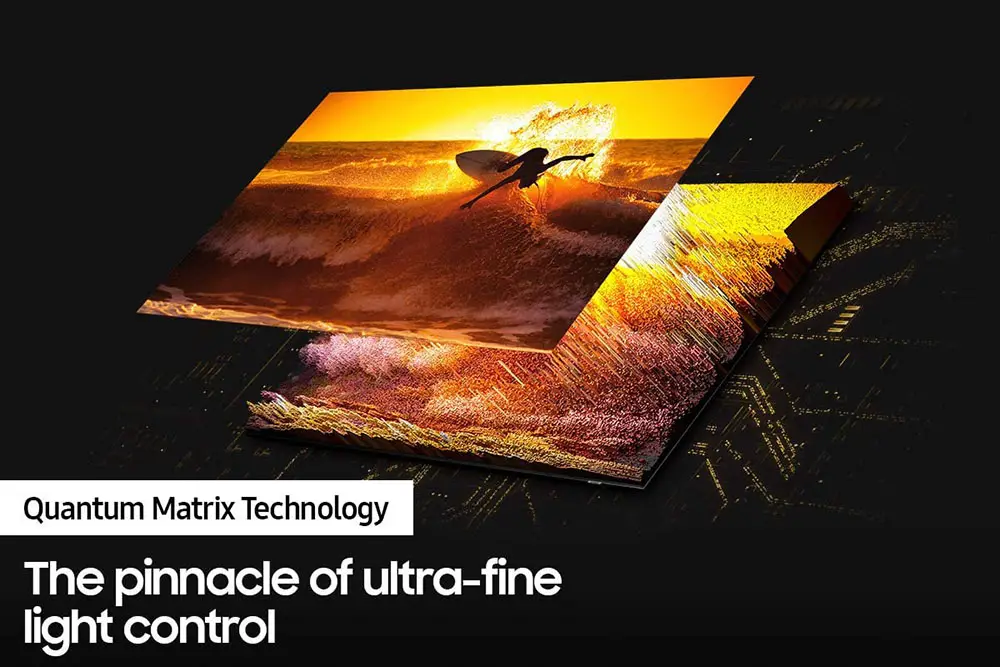
The 55″ version of the QN95B we are reviewing seems to be using the same zones configuration as the QN90B with 576 dimming zones in a 36 x 16 pattern. Again bigger sizes use more zones like the 65″ size that comes with 720 zones while even bigger sizes use close to 1,000 zones.
In terms of blooming the QN95B performed really close to what we had seen in the QN90B. There was still blooming visible but this was not very obvious or distracting. If you look for it you will certainly see it but in most real world content it is not going to bother you and it becomes noticeable only in very specific scenes like when you have subtitles in a completely dark background.
Zone transitioning was also very satisfactory and the algorithms were very capable at keeping up the pace with fast transitions between the zones when objects would move fast across the screen. It was not perfect but to be honest it was much better than some other brands we had seen recently.
All in all the mini LED backlight along with its local dimming fared very close to the QN90B and in general the system managed to keep blooming at minimal levels. Samsung has done a great job here and this is one of the best LED LCD TVs you can buy to this day.
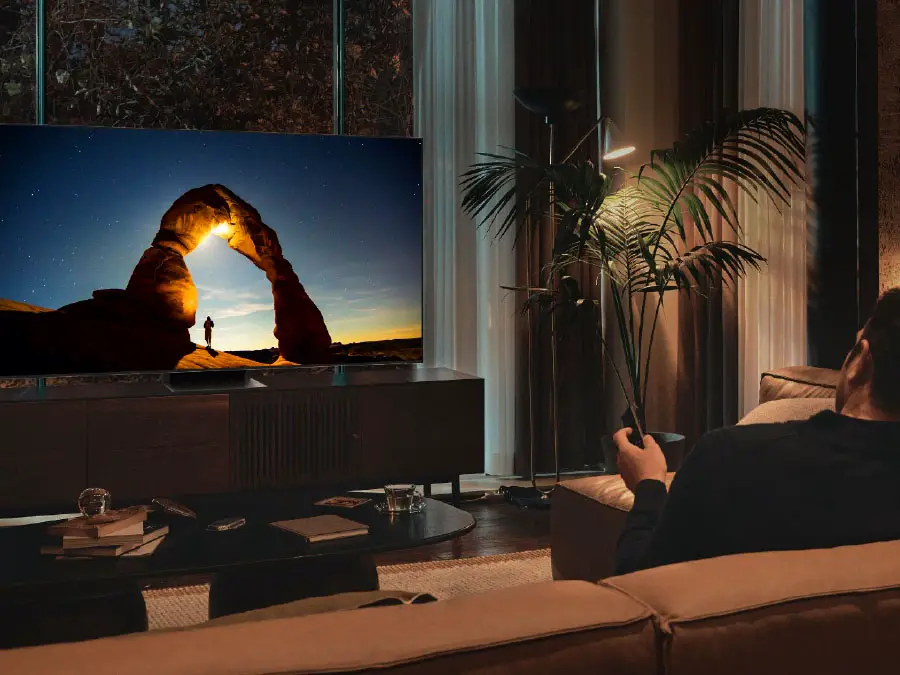
Brightness / Contrast
Brightness is one of the most important aspects of any HDR TV nowadays as with HDR content the need for high brightness output is bigger than ever.
For our review we used the Movie mode and Warm 2 color tone along with Local Dimming set to High which is a fairly standard setup for most Samsung TVs. In our SDR brightness test over a 10% white window we measured 1,905 nits which is great and is not only enough for any kind of SDR content but it can even combat glare in any kind of light room conditions.
On our HDR brightness test over a 10% white window we got 1,847 nits of brightness which again is very good and will make HDR content look wonderful. The QN95B may not be the brightest TV we have tested but still with such high numbers you should get the full HDR experience and then some.
Brightness levels followed the EOTF reference values very close up to its roll-off point but we did notice some shadow detail crushing. The curious thing was that Movie mode was more accurate than Filmmaker mode, something that we have seen in some other Samsung releases also.
In terms of contrast the QN95B comes with a VA panel (for the 55″ unit we had for testing), and as a result it scored extremely good. Although the TV comes with Samsung’s Ultra Viewing Angle technology, blacks were deep enough and with its local dimming images looked even better overall.
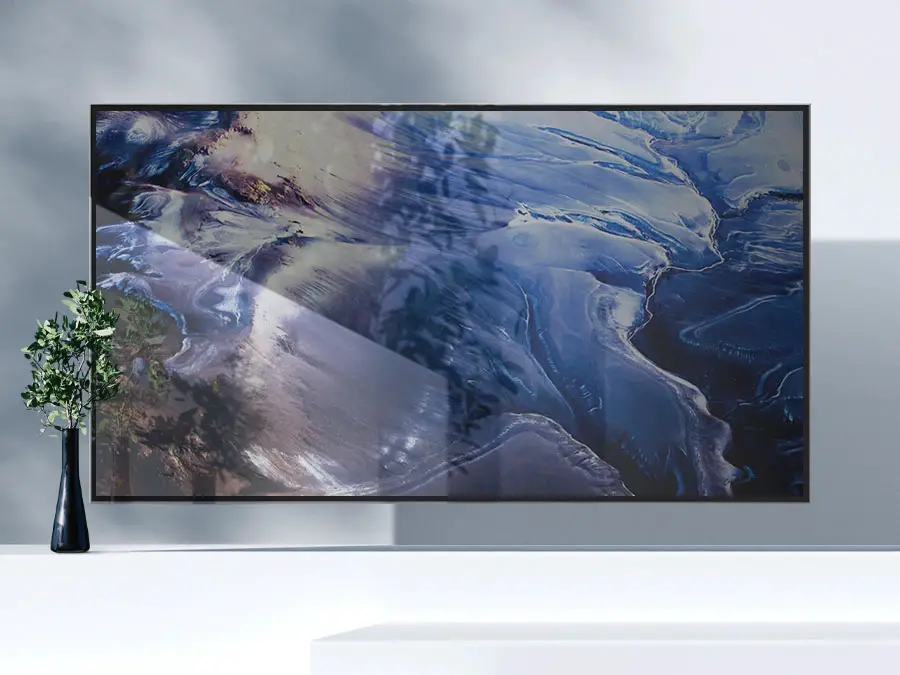
In pure numbers the QN95B performed slightly lower than the QN90B which is strange considering the fact that the two TVs use the same backlight system configurations. But the difference is not so big to make a visible impact on quality and both of them should be considered equals here.
Viewing angles
Regarding viewing angles things are pretty much the same with all the other flagship Samsung models before it. The QN95B is equipped with a VA panel which in general doesn’t mean good things when it comes to viewing angles. In order to combat this Samsung has used what they call Ultra Viewing Angle which is a technology that minimizes the light leakage by focusing the light on the right direction and as a result we can get better image results at far greater angles than without it.
Also a glossy coating called Anti-Glare technology is used to minimize the reflections from strong lights.
In the case of the QN95B we would say that this extra layer helps a lot in order to bring the viewing levels up to average levels although in no way it can compete with what OLEDs can do nowadays. The combination of the Ultra Wide Angle and Anti-Glare technologies allows for a maximum of 40 degrees of angle from the sweet center spot which is the most these LED LCD TVs can do nowadays.
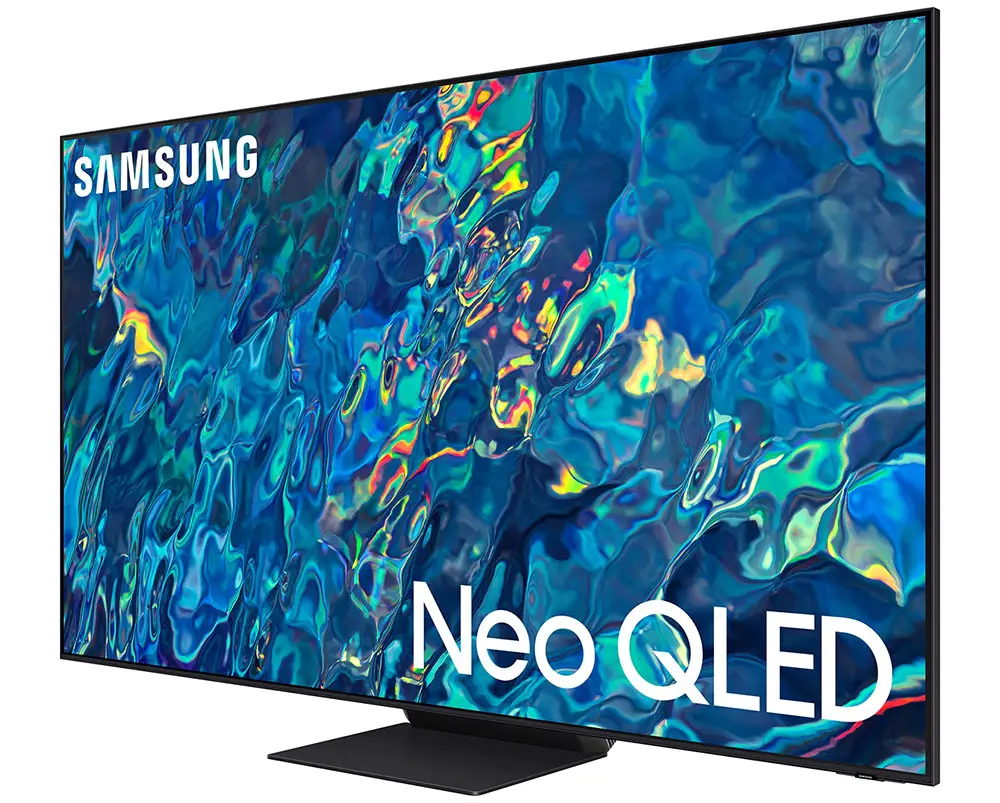
Samsung have been using the same tech on all their top tier TV so there is practically no difference here between the QN95B and the QN90B.
HDR support
HDR support is universally similar across their entire release lineup while the QN95B specifically comes with Samsung’s Quantum HDR 32X certification which is another indication how similar the system of the QN95B is compared to the QN90B which came with exactly the same certification number.
Keep in mind that this certification doesn’t mean much by itself but it gives us a small hint of how bright and how many zones the TV uses in comparison to their other releases.
The TV obviously supports the most basic HDR10 that is required for 4K UHD playback, there is HLG that is used mainly for broadcasting along with the newer HDR10+ which is the most advanced HDR protocol that uses dynamic metadata in order to provide the best image quality on a frame by frame basis, similar to what Dolby Vision is doing.
The QN95B comes also with HDR10+ Adaptive and HDR10+ Gaming. HDR10+ Adaptive uses its AI engine to analyze the viewing environment, including the lighting, brightness and even reflections using the sensors equipped on the TV. The results are then incorporated into the dynamic metadata, and then through four further steps, the brightness and contrast of a scene are optimized. This way you can view HDR10+ movies and television programs in various environments at home.
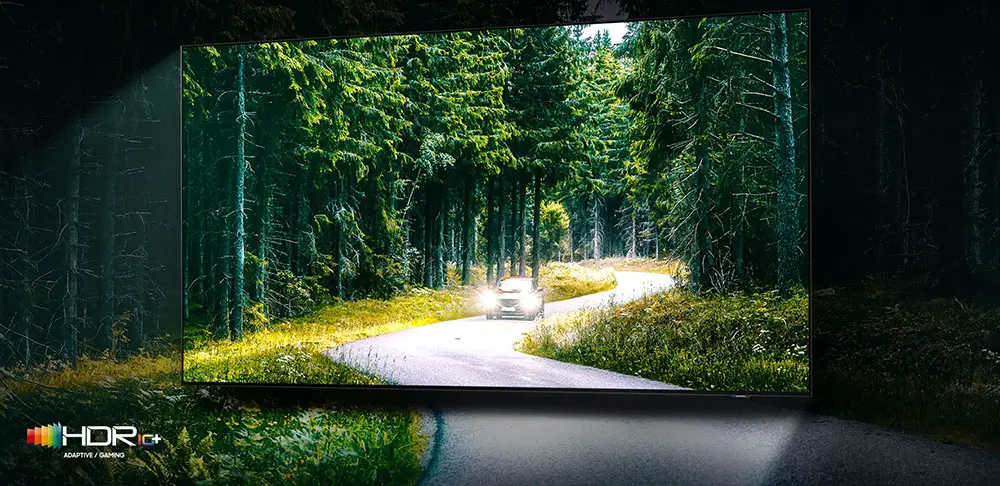
If you are on the lookout for a Dolby Vision TV then you should stop right here. Samsung, unless something dramatically changes, is not going to support Dolby’s advanced HDR protocol and chose their own path with HDR10+. In terms of quality there is not much difference between the two but Dolby Vision surely has a strong foothold at the moment across all formats.
Color coverage
The QN95B, being in essence a QLED, uses Samsung’s special Quantum Dot layer in order to display more vivid and lifelike colors. Samsung always claims 100% coverage of the DCI-P3 color space for all of their QLED and Neo QLED series but these numbers are just marketing material and they never correspond to real performance. And this is why we are here.
According to our measurements the TV has about 92% coverage of the DCI-P3 color space which is really good but not the best we have seen in a TV. On the wider REC.2020 color space we got a coverage of 69% which is again good but could have been better.
Compared to the QN90B the numbers we got were extremely close to each other and small differences could very well be due to the different panel we had for testing.
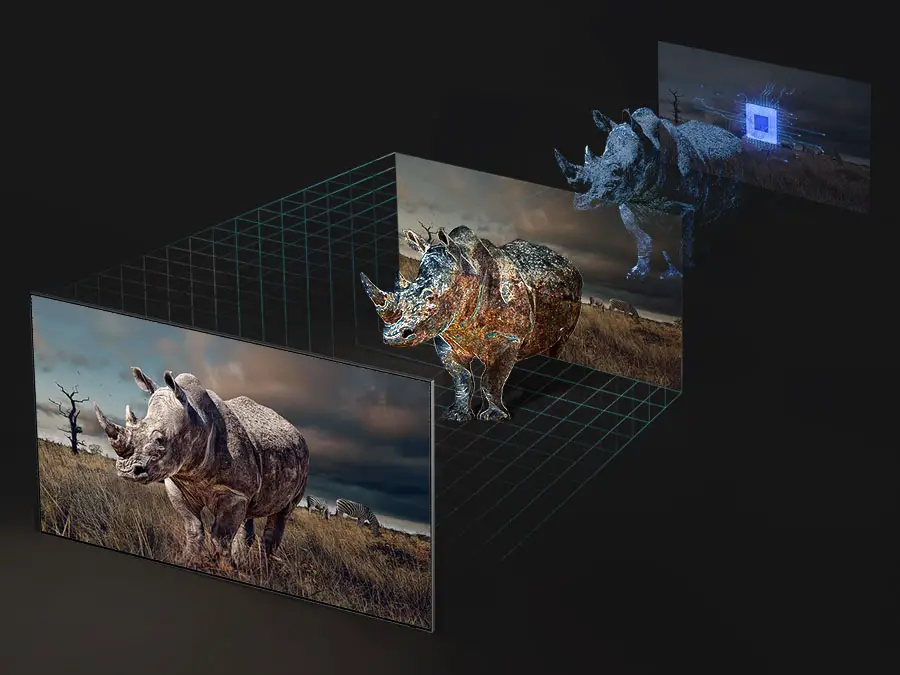
Before calibration the QN95B had good color accuracy but not the best we have seen as white balance needed some fixing. Also most colors had values below the DeltaE limit of three which was enough to makes the image look great even without any deep calibration. After further calibration everything looked even better as the white balance problem was fixed and color temperature was closer to its target value.
Color gradients were very good although we did see some banding in the darker green shades. There is also a Noise Reduction function in case banding is bothering you but you are going to loose some fine detail if enabled so use it only if it is a real problem to you.
Motion performance
We move on to our next part which includes our motion performance tests. The QN95B is a bit different here compared to the QN90B as it has a 144Hz capable panel along with a backlight dimming frequency of 960Hz. Having such a high frequency ensures that flickering is completely invisible but this also depends on the picture mode and specific settings that you will be using as with some of them the frequency drops to 120 Hz.
Obviously we also get motion interpolation which once again is named Motion Xcelerator Turbo+. The QN95B was not all that different from the QN90B here as from what we saw the TV was capable at smoothing low frame rate motion but as usual artifacts would become visible when the camera would make fast movements or objects move too fast. Some stutter was also noticeable during low frame rate content which could only be eliminated by enabling motion interpolation.

Enabling motion interpolation can be done, in the same way as with all other Samsung models, by going in the Picture Clarity settings in the menu and by adjusting the two sliders for blur or judder. Keep in mind that very high values in the sliders and the “Soap Opera Effect” will appear so if you want to improve motion but you hate the SOE effect keeping minimal values in these two sliders, like 1 or maximum 2, is your best bet.
Black Frame Insertion (BFI) is also available as usual which can be enabled in the menu with the LED Clear Motion option. BFI is a technique that inserts a black frame in between two individual frames in order to smooth out motion. Although the end result is very good, it has a couple of side effects. First due to the black frames, brightness takes a visible hit while due to the lower frequency used which can be either 100/120Hz or even 50/60Hz some flickering may become noticeable.
Overall very similar behavior to the QN90B here. The TV has solid motion performance but not without some issues. Motion interpolation does help in some instances but use this wisely as it can have undesirable effects.
Input lag
Next is our input lag tests and if the last few years is any indication then the QN95B should be in line with the rest of TV releases giving us really good values here.
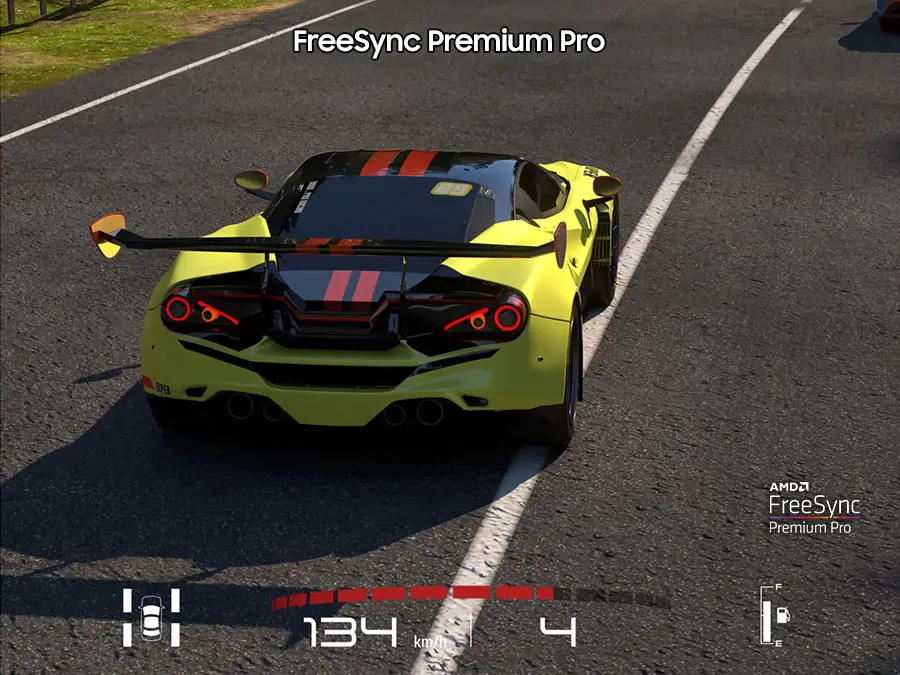
From our testing the QN95B measured an average of 10.8ms input lag in both 1080p and 4K resolutions at 60Hz with the use of Game mode. At 120Hz input lag went further down to 6ms in both 1080p and 4K resolutions which is as good as it gets really.
Now, if you want to use a different mode then the input lag rises to 75ms average in 1080p and 4K resolution which to be honest can still be really good for many kinds of games but mostly for slow paced offline ones.
Obviously the TV supports Auto Low Latency Mode (ALLM) that can be used with any devices that support it like the PS5 and Xbox consoles and can greatly benefit users. Once again we get HGiG Mode which is HDR Gaming Interest Group’s technology that ensures that you enjoy HDR games the way that their creators and developers intended.
The QN95B joins the rest of Samsung’s top tier releases with its support for FreeSync Premium Pro which can vastly improve your gaming experience if you have a device that also supports AMDs solution. Along with it we get support for all other VRR technologies including HDMI Forum VRR and NVIDIA G-Sync which can be enabled from the new Game Bar 2.0.
One difference we found between the QN95B and the QN90B seems to be that the QN95B supports 144Hz across all sizes which was not the case with the QN90B as only the 43″ and 50″ sizes had this ability and the rest would only go up to 120Hz. Although consoles cannot do 144Hz if you are a PC gamer and interested in such high frame rates then the QN95B will surely cover you in that respect.

Before closing this part of our tests we connected our PS5 and tried a couple of games like Call of Duty: Vanguard and Astro’s Playground with both of them having VRR support. Everything rendered nicely on screen and all our commands registered blazing fast. No delays and no slow response times resulted in a literally perfect gaming session.
Image quality impressions
In terms of pure picture performance the QN95B does not offer anything substantially different from the QN90B. The better processor doesn’t show any real difference while in all other tests the two TVs came really really close to each other. The only meaningful difference is the support for 144Hz across all sizes.
Overall the QN95B behaved like a true flagship. Nice 4K images, good upscaling capabilities, lifelike colors, solid motion performance, good contrast, acceptable viewing angles and blazing fast input lag makes what Samsung’s 4K LED LCD flagship is all about.
If picture performance is your only concern and you don’t care about anything else like the One Connect Box then we would suggest you to go for the QN90B and save some serious buck. The QN95B is really good but in terms of image quality it has nothing more to justify the higher price. The 144Hz alone is surely not enough.
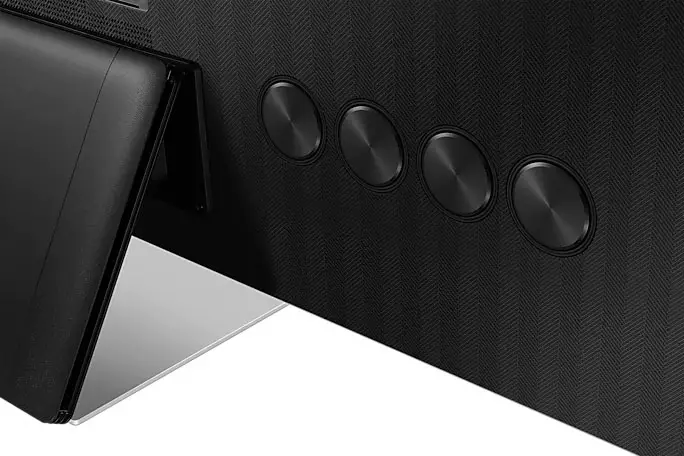
Audio Quality
If there is one area that manufacturers are still struggling with after so many years is in the audio department. These ultra slim TVs simply don’t have the space required to equip them with audio systems capable of offering more immersion and better sound. We have seen most TVs lately incorporating various techniques and features but most of them are mostly software based and the end result is not much better than what we would hope for.
It’s been a couple of years now that Samsung has developed their own audio system for many of their top tier and mid offerings called Object Tracking Sound and as of 2021 there are four variants of this system depending its capabilities. We have the OTS Pro, OTS+, OTS and OTS Lite and QN95B is using the OTS+ variant which is very similar but not entirely the same as the one used in the QN90B.
The one used in the QN95B uses a 4.2.2 channels audio system with a power rating of 70 watts of power which is 10 watts more than what the QN90B can output. Don’t expect this to make a huge difference but it’s an upgrade that should be mentioned nevertheless.
The system is more than enough for casual use including all kinds of broadcasting material and sports but if you look for cinematic immersion you are going to be disappointed. Sound lacks the desired depth, surround activity and low end prowess to make it worthwhile. If that is what you seek then you will surely need a soundbar or dedicated surround system to get the most out of this TV.
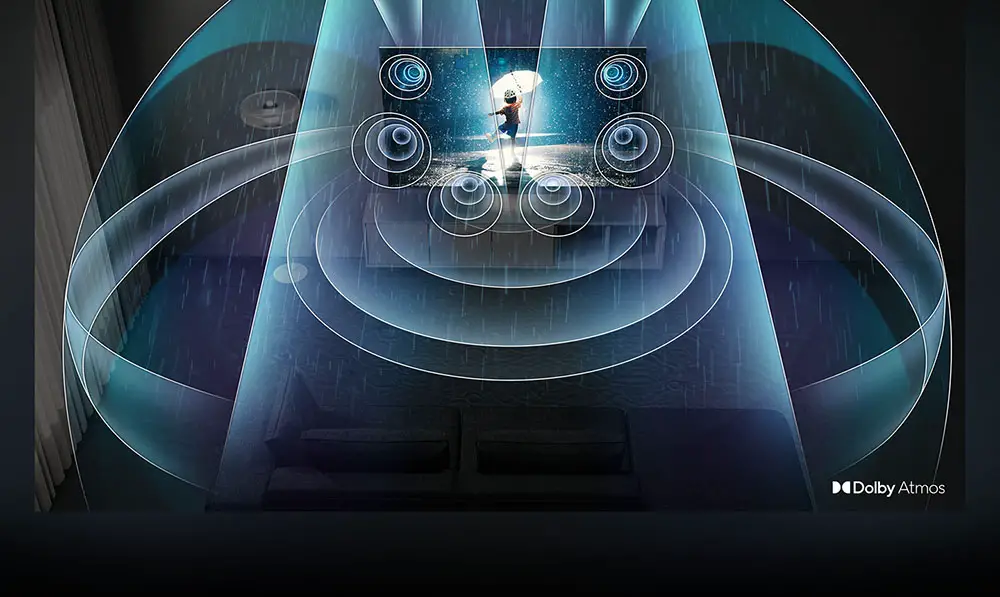
It also supports Dolby Audio and for the first time for Samsung it even can do Dolby Atmos but that doesn’t mean much even if the TV comes with a system like the OTS+ because there are no height speakers that could really bring the height layer to life. Dolby Atmos can be passed-through the included eARC to some Dolby Atmos soundbar or dedicated sound system in this case.
DTS support is completely absent once again this year as it is not only missing from native support but it cannot also be passed-through from any of the available ports which is rather disappointing. And this applies for all Samsung TVs, either low cost or top tier premium ones. From the big three Sony remains the only one that still supports DTS sound.
There are a few additional audio features that are worth mentioning and come in all premium Samsung releases. The first one is called Adaptive Sound+ with which the TV analyzes the content being played and for each scene can identify and render the best sound type. This whole process starts by separating and classifying audio input signals. Key characteristics are then pulled out and rendered to best suit the scene.
Another feature is Active Voice Amplifier (AVA). With it the TV can detect environmental noise and enhance the voice output of the content you watch for a more pleasant viewing experience.
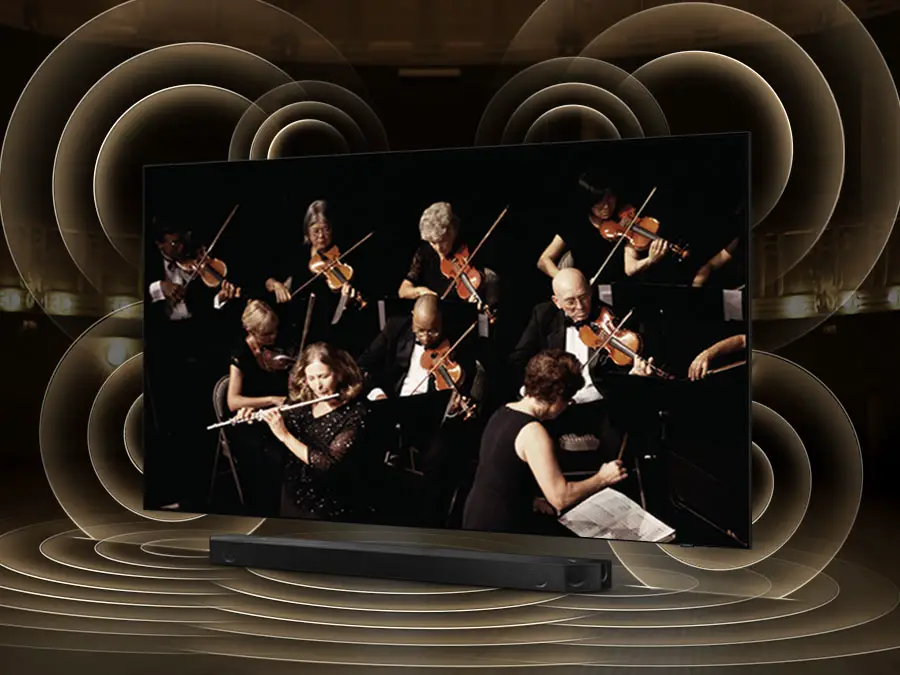
Lastly we get Q-Symphony which is a feature that you can use to combine the TVs audio system with an appropriate soundbar that also supports that. This way the audio will be synced and output from both devices for even higher immersion. Samsung has released a whole lineup of soundbars that support Q-Symphony in case you are thinking of getting one.
In general sound is a bit of an afterthought but certainly not bad. For everyday use it can be adequate and compared to a simple 2.0 channels system the OTS+ in the QN95B is a big step up. It’s just not enough if you seek to combine the TV’s excellent image quality with audio that will immerse you into the action.
Ports and Connectivity
As we mentioned above all ports of the QN95B are located on the One Connect Box which is a unique and brilliant idea that unfortunately has become a niche premium feature instead of a widely used one.
On the box itself we find a port that connects the box to the TV itself, three USB ports, four HDMI inputs, an Ethernet port for wired connection to your local network, a digital optical audio output, an Ex-Link port and the usual antenna/cable connector.
The good thing is that all four HDMI ports are HDMI 2.1 with a peak bandwidth of 40Gbps. Having HDMI 2.1 means that the QN95B supports all new and old features including 4K@120, ARC, eARC, ALLM, VRR, G-Sync, FreeSync Premium Pro, HFR and HDMI-CEC.
Unfortunately for one more year the Ethernet port will only support up to 100Mbps which is a real shame but not entirely surprising given the fact that all manufacturers still include 100Mbps adapters in their TVs. Hopefully this will change in the future as Gigabit adapters should be the standard by now.
In terms of wireless capabilities there are no surprises as the QN95B supports WiFi 5 (802.11ac) along with Bluetooth which in 2022 has been updated to version 5.2.
OS, Apps and Features
Being a Samsung TV means that for its OS we find the usual Tizen platform which has been updated to its 2022 version and what we have here is basically the same OS we have seen in all other 2022 Samsung TVs like the recent QN85B and QN90B. There is no difference whatsoever so this part of our review will basically be a repetition of our previous observations for the platform.
Samsung decided to follow Google and LG and made the new Tizen occupy the whole screen instead of being a tile based row at the bottom of the screen, exactly as Google TV and webOS are this year.
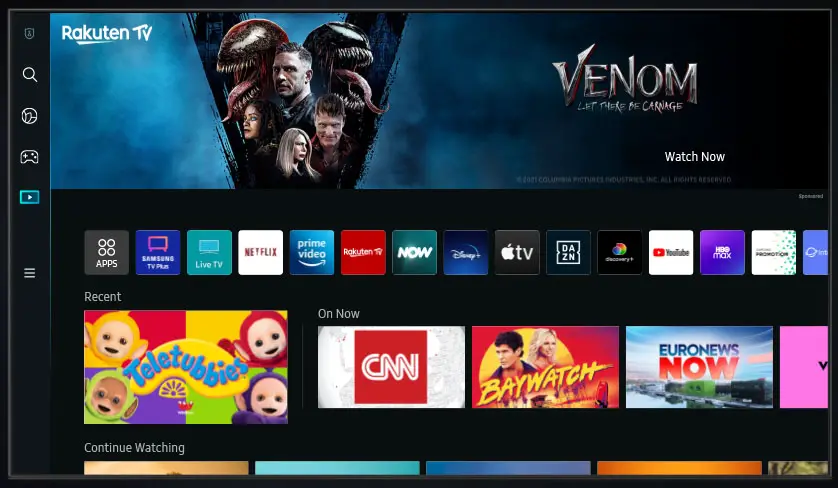
It seems that smart TV platforms opt for a more personalized experience and as such the new Tizen 2022 tries to provide you with options that are tailored for your viewing habits. As such there are personalized ads, recommendations based on your viewing patterns both for streaming services and broadcasting channels and even shopping suggestions.
If you have used Tizen before, the new version may feel a bit chaotic at first. This was the same with Google TV and webOS and certainly you will need to spend some time with it to get your bearings. But once you get the hung of it, it is easier to navigate than it may seem.
The new Samsung Smart TV Hub is separated in different sections and it allows you to navigate easily through all of them. At the left of the screen there is a single column with a few central selections including Media, Gaming and Ambient while the rest of the screen is divided in rows with streaming services, apps and other functions and features available.
Having tried both the latest Google TV and webOS we can say that the new Tizen is not all that different. Obviously the layout is tailored to Samsung’s needs but in essence it offers the same thing. Navigation was smooth enough and jumping from one app to the other was relatively fast and with no obvious lags or delays.
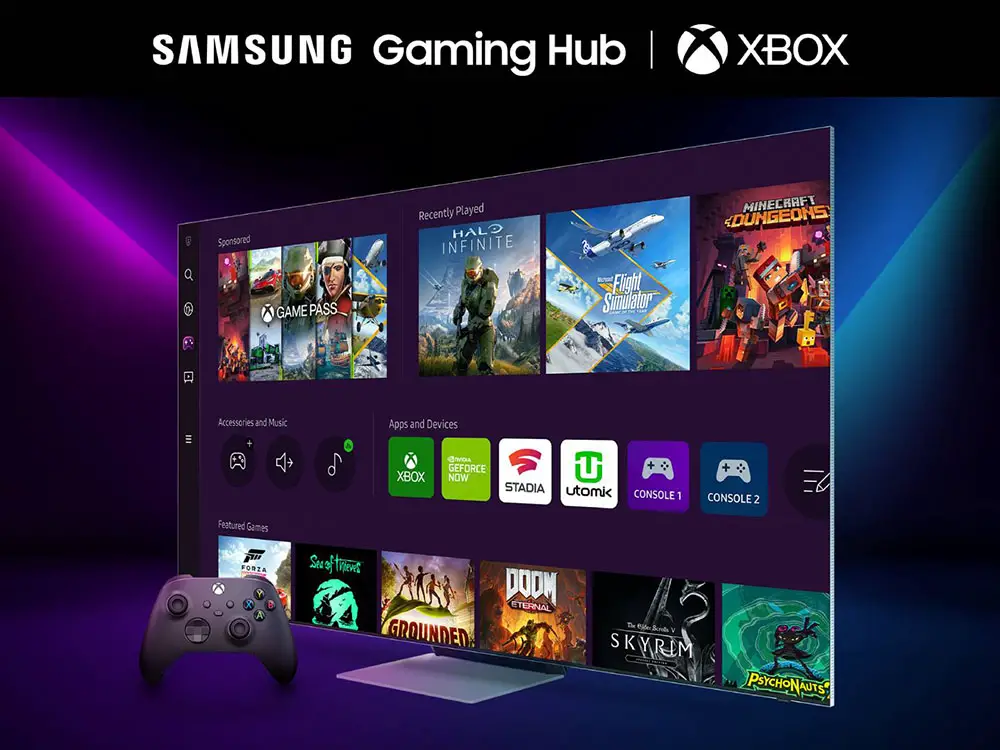
Except from the visual overhaul the new Tizen comes with a few updates, although fundamentally it offers the same kind of functionality we had experienced last year.
The Super Ultrawide GameView & Game Bar that was introduced last year makes a return but now it is called Game Bar 2.0 and got an update along the way. This is an on-screen menu that lets you make real-time adjustments to screen ratio, input lag check, FPS, HDR, wireless headset settings and more. This can be a really handy feature to gamers as you don’t have to mess with menus every time you want to check on a specific setting. With this quick feature you have everything in front of you with the click of a button.
When it comes to content the Tizen platform is famous for it’s enormous support from developers. The QN95B comes with practically all known services and platforms you can think of with Netflix, Apple TV, Disney Plus, Youtube, Amazon, Hulu, Rakuten, Demand 5 and BBC iPlayer just a few of the big names available with some of them obviously being region dependent.
There is also Samsung TV plus which offers hundreds of subscription-free channels to choose from. Many of these services can playback in both 4K with HDR like Netflix and Amazon but this is very much app dependent.
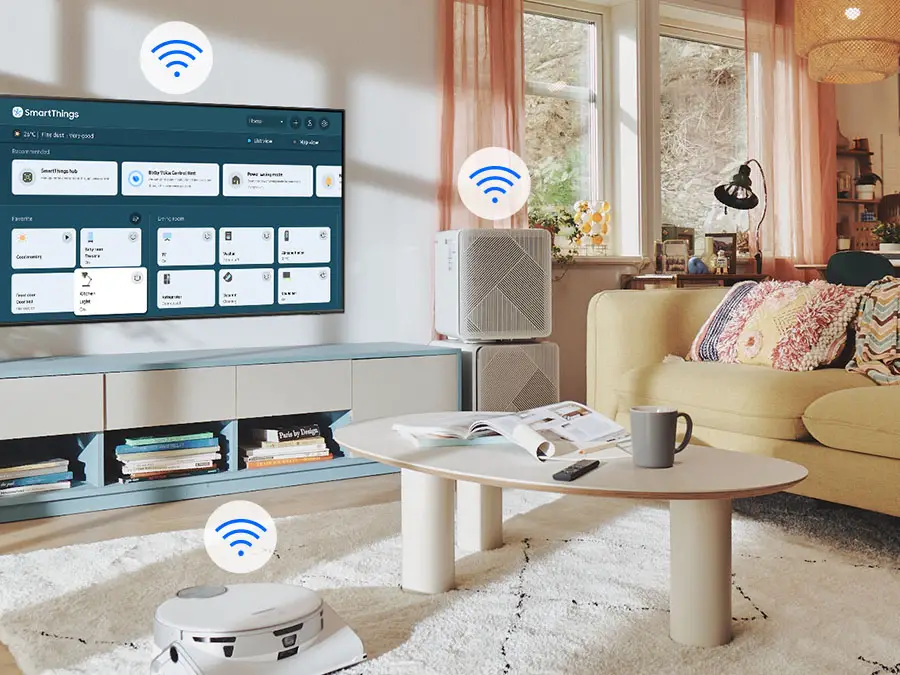
A function that has been retained from the last few years is SmartThings integration. With it you can make your TV the central hub of all your smart house devices. These can be lights, electronic locks, alarms, vacuum robots, thermostats and everything that supports the SmartThings platform.
Obviously another feature that could not be missing is voice control. It seems that Samsung is really trying to market their own Bixby service but even if you are not very fond of that there is Amazon’s Alexa or Google Assistant to choose from. While if you are an Apple guy then don’t get disappointed as there is also Airplay 2 support and you can use Siri through it for your voice commands. Unfortunately while Airplay is available HomeKit is not.
Another feature that was introduced a couple of years ago and seems to be a standard now is Multi-View and although at it’s core it’s not something entirely new Samsung took it a step further. Multi-View is basically a more advanced screen mirroring and with it instead of just simply projecting the screen from your mobile device on the TV you can choose to have two screens showing both TV content and what your mobile device shows.
In addition to Multi-View there is also Tap View and with it you can mirror your phone on your TV with just a tap to continue enjoying movies, music, and apps on the bigger screen within seconds.

Another returning feature is Ambient Mode+ which is a slightly enhanced version of the Ambient Mode we get in many Samsung models for the last few years. With the plus version now except from the ability to display various images on the TV when not in use it can also project various information including weather updates, news headlines, photos and music.
Samsung Health is another returning feature from last year. Last year with the coronavirus pandemic many people were staying indoors so Samsung thought that exercise at home would be on the rise. So many of their TVs came with Samsung’s program in order to stay in shape. It seems that Samsung liked it so they kept it in for another year.
A new feature in 2022 seems to be the inclusion of Google Duo which allows for video chat of up to 32 people if you connect a web camera to the TV itself. Although we cannot imagine a lot of people using it, it’s good to have it as an extra. The more the better.
Being Samsung’s 4K LED LCD flagship, the QN95B could not be missing any features available in Samsung’s arsenal either premium or standard. As such what we have here is the full set of extras available for 2022 which is more than what most people will ever need really.
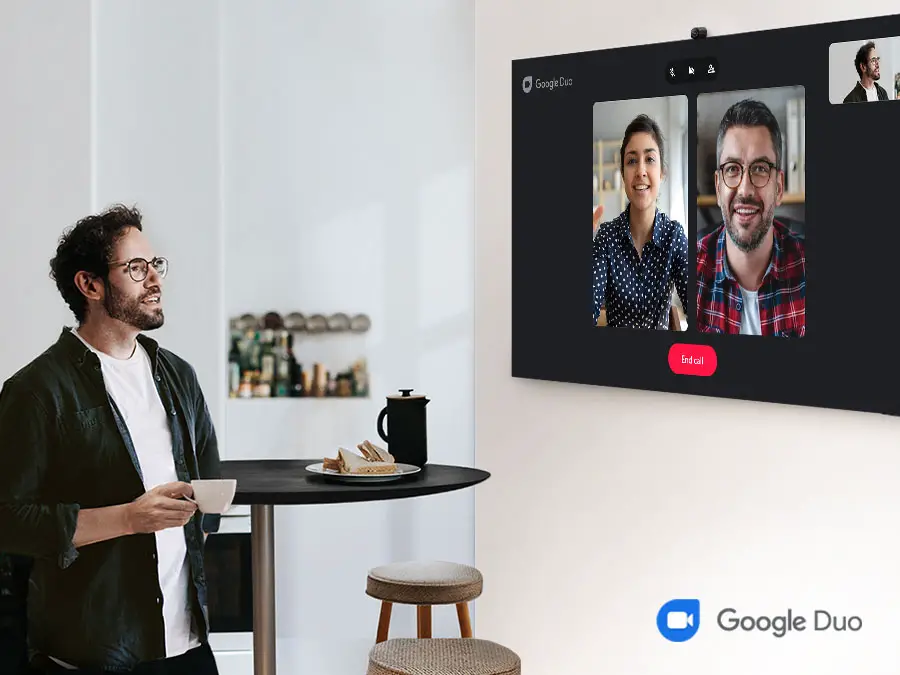
Final Thoughts
If you are wondering if it is worth it to go for the QN95B instead of the QN90B what we can tell you is that it really depends what you are looking for. If image quality is the only thing that matters to you then the QN95B is absolutely not worth it. You are going to pay $800-$900 for basically the One Connect Box and 144Hz refresh rate and that’s all there is to it.
Now on the other hand if you absolutely need one of these two, or both, then you have no other choice than to pay the extra premium price for it. In our honest opinion the extra cost it way too much for the One Connect Box but this is Samsung and this is the price you have to pay for their premium products.
In terms of image performance the QN95B showcased all the same strengths we saw with the QN90B including great 4K upscaling, very good brightness, solid motion performance, adequate viewing angles, low input lag, extremely good contrast and accurate colors. Adding to these the four HDMI 2.1 ports and the latest Tizen and you have a real flagship in your hands.
But as no TV is without its flaws the QN95B still had some visible blooming, even if this was less than other models. There is also no Dolby Vision and no DTS support while the sound system is not meant for anything more than casual use.
Closing our review what we can say is that the Samsung QN95B is not a bad TV, not at all. It is just meant for a very specific audience that wants to have either 144Hz for PC gaming or need the One Connect Box, or both. If you belong in this category then unfortunately you will have to pay the extra price for it, otherwise the QN90B will suffice and you can save some major buck from this.
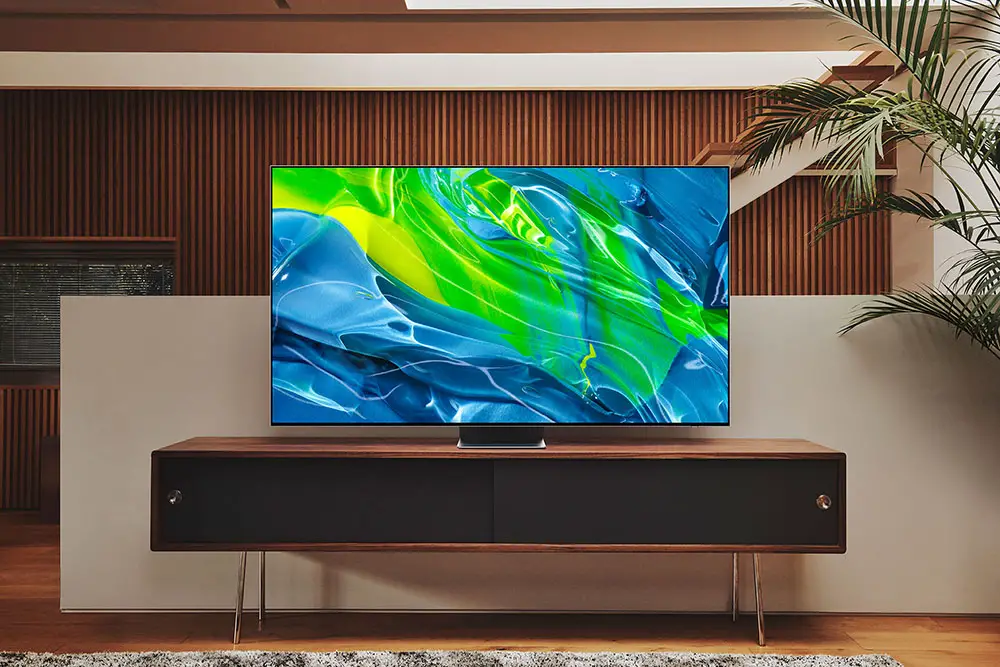
For more reviews you can check our dedicated 4K LED LCD TV reviews list or even look at our Product Reviews Table where you can find the brand and specific product you are looking for.
Cheapest Places to Buy :
*We are a reader-supported website. When you buy through links on our site, we may earn a small affiliate commission at no extra cost to you. Home Media Entertainment does not accept money for reviews.*

Hi there,
I love the One Connect Box. I had a 2016 KS9000 and I really loved it as it was such a convenient feature to have. And since I am considering a new Samsung the QN95B is a must for me as I really want to get one with such a box again. Being able to position it away from the TV makes my setup so much cleaner!
Many thanks, Tandeka
The One Connect Box was a really brilliant idea from Samsung. It’s a pity that we see it in only a handful of their releases. They could really take advantage of such a unique feature.
Very nice and detailed review you wrote there. One of the best I have seen for this TV. By the way, do you know what kind of TV would be good if it’s about 8 meters from the point of view? How big would it have to be? I am still considering the best size to go for.
Hey John. There is really no best size for each distance. The best size is what you find most comfortable at. For example a 55″ TV is good up to 3-4 meters. But this is not a given as you may be ok with a smaller size also. That’s why when it comes to TV sizes it’s best to go to a local retailer and check the distance by yourself.